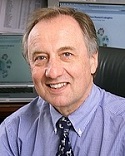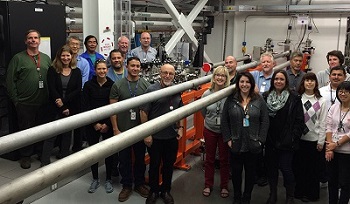Vol. 16, No. 6 - January 2016
View the Archives

Science Highlights
Effect of an Ultrathin Coating on Stabilizing Li-ion Battery Cathodes – Contacts: Anna Wise, Johanna Nelson Weker and Mike Toney (SSRL) The widespread adoption of renewable energy in many applications, such as electric cars, is dependent on the development of better batteries. A lithium ion battery can be made to have a higher capacity, better thermally stability, and lower cost by changing the cobalt component of the battery cathode (usually LiCoO2) to a mixture of nickel, manganese, and cobalt. While providing great benefits, this material, known as NMC, also has a downside: increased reactivity at the cathode resulting in a shorter battery lifetime. To counteract this reactivity, scientists have developed a coating for the NMC cathode. Read more...
Revealing a New Conformational State in a Chloride/Proton Exchanger – Contacts: Merritt Maduke (Stanford University) and Emad Tajkhorshid (University of Illinois at Urbana-Champaign) Ion transport across the hydrophobic barrier of the cell membrane is central to life. Biological membranes are hydrophobic barriers that are impermeable to ionic species. Thus, ionic movements across these membranes require catalysis by specific proteins situated at the membranes such as ion channels and transporters. CLC transporters are such proteins that facilitates transport of chloride (Cl-) and protons (H+) across biological membranes. Read more... More SSRL-related ScienceBiologist Describes Milestone toward a Universal Flu Vaccine - X-ray Studies at SSRL Aid in Vaccine Design Excerpted from January 4, 2016 SLAC News Feature
Every fall, millions of people roll up their sleeves to get a flu shot. Up to 20 percent of the population gets the flu and more than 200,000 people are hospitalized with flu complications each year, according to the U.S. Centers for Disease Control and Prevention. While seasonal vaccines provide some protection, they are not always effective because the strains of influenza virus in the vaccine may not be well matched to the flu viruses circulating that year. So researchers are searching for a way to develop a more universal vaccine that would be effective against any variety of influenza. Scientists from The Scripps Research Institute and the Crucell Vaccine Institute have now designed a protein fragment called mini-HA that stimulates the production of antibodies against a variety of influenza viruses. Macromolecular cystallography experiments at SSRL enabled the research team to look at the atomic structure of the mini-HA at each stage of its development. Ian Wilson, a leading structural and computational biologist at Scripps and a long-time user of SSRL, led the research team. SLAC Communications asked him to describe the team’s flu vaccine research. Read more... HonorsStanford Scientist among '10 People who Mattered' in 2015 Excerpted from January 6, 2016 Stanford News Article
Zhenan Bao, Professor of Chemical Engineering and researcher at SSRL, was named to Nature‘s list of “10 people who mattered this year.” The journal described Bao as a “master of materials,” a chemical engineer who is merging electronics with the human body. She was lauded as a founder of the field of thin, flexible organic electronics, leading to the creation of medical devices that can be worn or implanted to monitor blood sugar and other vital data. Her team has also made progress in creating artificial skin that provides a sense of touch akin to natural skin. Her work is highly interdisciplinary. “It’s not just one idea,” she told Nature, “Many ideas came together and made this possible.” Instrumentation Developments at SSRL and LCLSCollaborative Effort between Stanford, SLAC Biosciences Division, SSRL and LCLS Sees First Light at LCLS' New MFX Experimental Station for Biological Experiments Excerpted from January 15, 2016 SLAC Today Article
For the first time in three years, LCLS has added a new instrument to its set of experimental stations. Staff from Stanford and SLAC gathered on Jan. 12 in the x-ray laser’s Far Experimental Hall to celebrate the arrival of the first x-rays in the brand new MFX hutch. LCLS’s seventh instrument, MFX will expand the facility’s capability and capacity by generating more opportunities for all kinds of groundbreaking user experiments. Although MFX can support a variety of experimental settings, it was specifically designed for macromolecular femtosecond crystallography. This technique provides atomic-resolution x-ray images and ultrafast movies of biomolecules in action. It will aid researchers in unravelling crucial biological processes, from finding new ways of fighting disease to developing methods to harness solar energy similar to photosynthesis. Read more... BL4 Optics Upgrade Scheduled May-July 2016 Beam Line 4 (BL4-1, BL4-2, and BL4-3) will be closed during most of our third scheduling period to address degraded mirror performance over the last several years. After evaluating the SSRL-wide upgrade needs as well as limitations in available staff and resources, we have determined that the best window for the BL4 mirror upgrade is May to July. We anticipate recommissioning the BL4 mirror systems in July just prior to the annual summer shutdown. SPEAR3 Update The SSRL storage ring team is in the final stages of installing hardware that will enable reducing the SPEAR3 emittance to 6 nm from its present value of 10 nm. The last piece is the installation of the thin septum injection magnet that will occur this summer. Work to implement the new lower emittance optics in SPEAR3 will proceed after the summer shutdown, with delivery for operations expected sometime during the FY17 user run. SSRL's summer shutdown will begin on July 26 this year to facilitate this SPEAR3 installation and other instrumentation development and installation projects. Upcoming EventsWorkshop on Small-Angle X-ray Scattering and Diffraction Studies - March 28-30, 2016, Menlo Park, CA The SSRL Structural Molecular Biology Group hosts a 3-day comprehensive workshop on the use of non-crystalline small-angle x-ray scattering and diffraction techniques in structural biology research. The workshop will focus on solution x-ray scattering studies on biological macromolecules and macromolecular complexes. The workshop will cover the basic theory of small angle scattering, experimental aspects of solution scattering as well as recent applications of solution scattering in structural biology research. We will have extensive software and data analysis tutorials covering all aspects from the basic SAXS analysis to advanced modeling methods. Participants are encouraged to bring their own solution samples for data collection tutorial at SSRL Beam Line 4-2 and the data analysis and modelling tutorials. Registration coming soon. SSRL School on Synchrotron X-ray Scattering Techniques in Materials & Environmental Sciences, June 21-23, 2016, Menlo Park, CA 12th International Conference on Biology and Synchrotron Radiation, August 21-24, 2016, Menlo Park, CA The International Biology and Synchrotron Radiation (BSR) meetings are held every three years with the aim of presenting and discussing state of the art applications in relevant research fields, providing a unique opportunity to discuss the novel possibilities of synchrotrons and x-ray lasers and to promote their applications to challenging biological problems. This meeting provides a forum for scientists involved in research and development on synchrotron and free electron laser sources to come together with a broad community of biologists, with the ambition to make the best use of the most advanced infrastructures in structural biology. Possible applications range from atomic-resolution and time-resolved structures of biological macromolecules, medium resolution images of the largest molecular complexes in the living word, and cellular and sub-cellular structures. Scientists at all possible career levels are invited to this meeting – ranging from graduate students, postdoctoral fellows, and principal investigators both from academia and industry. There will be ample opportunities for individual presentations. Conference website User Research AdministrationBeam Time Request Deadline February 22 is the next X-ray/VUV Beam Time Request deadline for May-July scheduling. Submit proposals and beam time requests through the user portal. We encourage users to 'bookmark' this SSRL Deadlines page and set a reminder for these annual deadlines in their calendars. Deadline reminders are also included in user portal. User Portal Update An updated version of our User Portal is coming soon. Our development team has been working extensively to convert our User Portal pages to a responsive, mobile-friendly interface. Users should immediately find the newly redesigned top level pages easier to navigate through. Stay tuned.
The Stanford Synchrotron Radiation Lightsource (SSRL) is a third-generation light source producing extremely bright x-rays for basic and applied research. SSRL attracts and supports scientists from around the world who use its state-of-the-art capabilities to make discoveries that benefit society. SSRL, a U.S. DOE Office of Science national user facility, is a Directorate of SLAC National Accelerator Laboratory, operated by Stanford University for the U.S. Department of Energy Office of Science. The SSRL Structural Molecular Biology Program is supported by the DOE Office of Biological and Environmental Research, and by the National Institutes of Health, National Institute of General Medical Sciences. For more information about SSRL science, operations and schedules, visit http://www-ssrl.slac.stanford.edu. To unsubscribe from SSRL Headlines, just send an e-mail to listserv@ssrl.slac.stanford.edu with "signoff ssrl-headlines" in the body. To subscribe, send an e-mail to listserv@ssrl.slac.stanford.edu with "subscribe ssrl-headlines" in the body. Questions? Comments? Contact Lisa Dunn
|





